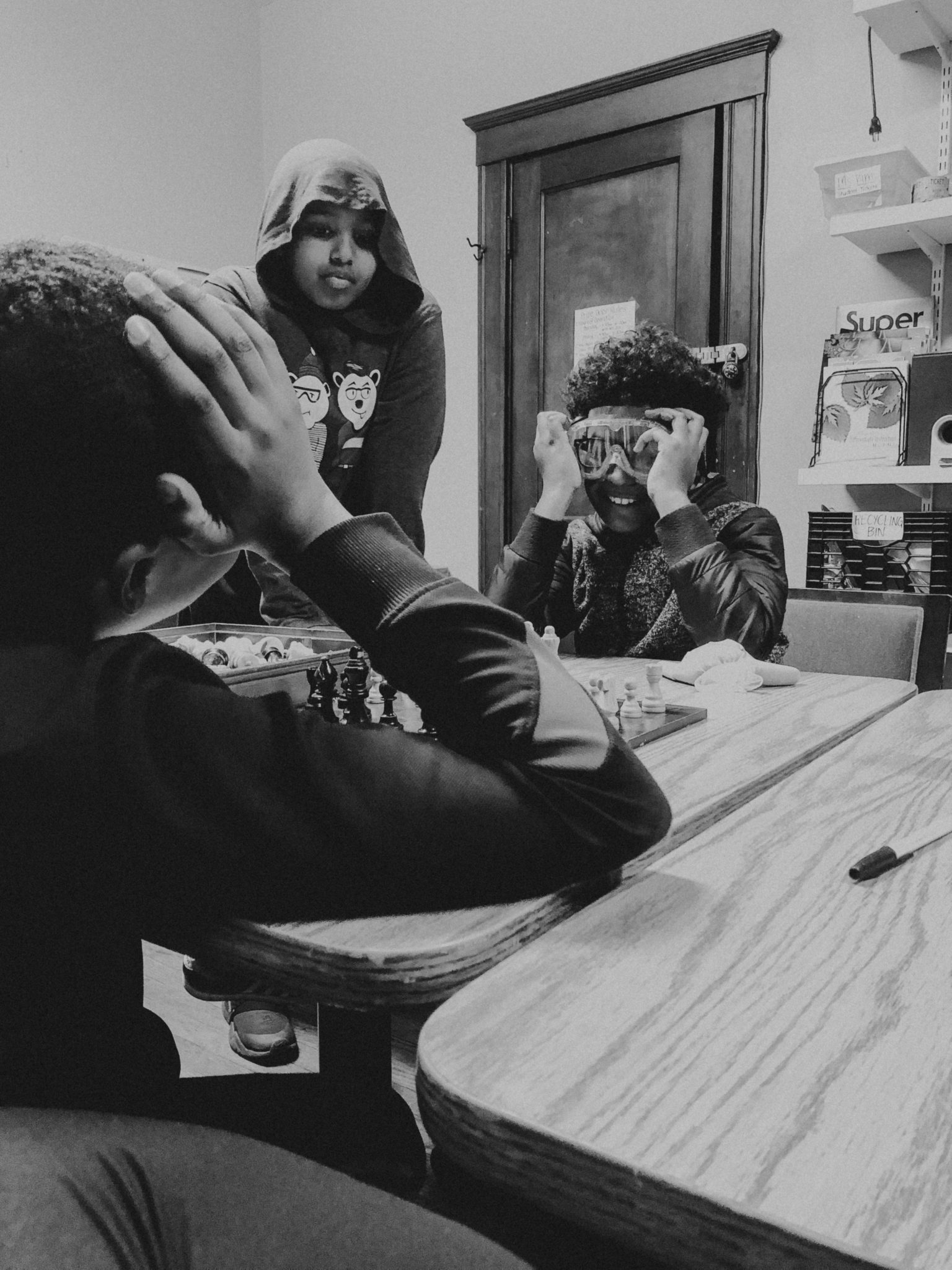Saving the Best for Last: My Final Co-op Payton ’22 at the Antioch School
Oct 04, 2021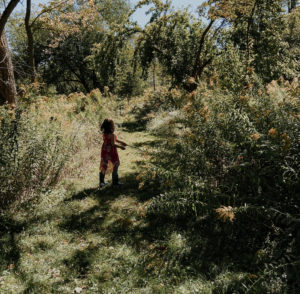
“A child is innately wise and realistic.” – A.S. Neill, Summerhill
On my first day at the Antioch School, I was told that the work that I would be doing at the school would be based mostly on observation. I was reassured not to be discouraged by this, for learning happens within discovery. I watch students all day long, from 10:00 am to 3:30 pm most days and as I wander around the school I watch them ride around their bicycle path with Ripstiks and unicycles, falling down only to get right back up and try again. At this school, children are encouraged to take the next step, to take risks, and to make mistakes. The Antioch School is a place where childhood is respected and children are enjoyed.
In 1921, the Antioch School was founded by Arthur Morgan as one of the country’s first alternative schools. The Antioch School prides itself on being a democratic educational institution, meaning both the students and the teachers collaborate together to create the curriculum and classroom rules they wish to follow for the academic year. Unlike other schools, the Antioch School allows students to take full advantage and ownership of their own learning. Arthur Morgan, the founder of the Antioch School emphasized that education should teach children about the joy of living, “Youth is naturally exuberant. School experiences… in discovering the tempting secrets of science and in listening to the appeal of good literature, history, music, and art, should help young people to acquire an appreciation of life which will carry over into their adult years the youthful joy of living.”
This democratic educational paradigm is replicated through the classroom dynamic in everyday experiences. There is no hierarchy within the classrooms, as the teachers all collaborate together with the school manager to make the school function as a whole. The different groups of students (Nursery, Kindergarten, Younger Group, and Older Group) interact with each other on a daily basis although each classroom has its own curriculum and class guidelines to follow. For the most part during my co-op, I have been working with OG and Kindergarten which has been incredibly rewarding to work with two drastically different age groups. Almost once a month, OG and YG students get together with the teachers for an “All-School Meeting” run by OG students. This meeting is where the students in both classrooms are given the space to talk about indifferences they have been facing or issues they have with the school. In our meeting this month, the students discussed solutions for the dirty bathrooms and hallways. I told them to not be embarrassed, that even at my school at Antioch College the adults I live with have trouble flushing the toilets and picking up their toilet paper. They laughed. I said I am not kidding.
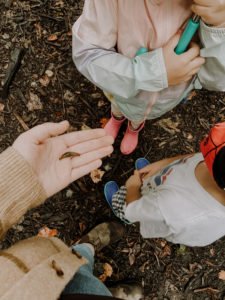
Slug friend!
When I visited the Antioch School for my job interview in the spring, one of the first things I noticed when I walked into the building were the unicycles lined up along the long windowed hallway. When I asked Nathan Summers, the current school manager, about the unicycles he told me that unicycles became a school symbol for the Antioch School beginning in 1969. Unicycles offer a “uni-que” challenge for students, an activity that requires consistent perseverance and patience. Something that might knock them down, but will also teach them the importance of tenacity and persistence.
At the Antioch School, the children are encouraged to pursue their natural curiosity. The teachers at this school all hold the same value that the primary role of an educator is to find and nurture individual student’s innate sense of direction and curiosity. As Ann Guthrie, the teacher of the Nursery group of children writes in Don Wallis’ book, Children of a Child-Centered School, “Teaching is a subtle art… I believe that good teaching comes out of good observing, knowledge of child development, intuition, an ability to read the individual, and a good sense of timing. A good teacher knows when to step in and when not to step in. I believe that teaching is much more art than science. I believe that teaching is also learning.”
Just like Antioch College, the Antioch School is a small school with a central belief that a safe, trusting, and loving community is central to learning. Each year the enrollment for the school averages out to approximately sixty students, ages three years old to twelve. The Antioch School is a small school tucked away in between the Antioch College campus and a nature preserve, the Glen Helen. At this time of the year, native Ohio wildflowers encompass the childrens’ surroundings. Goldenrod and purple aster flowers sprout around the school, a building with a hallway of glass windows that allows natural light to flood the classrooms filled with houseplants, books, and crafting supplies.
They have a garden where they planted tomatoes, pumpkins, cucumbers, and peppers to enjoy for afternoon snacks. Just beyond the garden is a chicken coop where three chickens (Sleepy, Jaz, and Easter) are chased around all day. On the playground, they have a merry-go-round, a tire swing, a giant sandpit, monkey bars, and swings. At the Antioch School, play is prioritized so we spend most of our time outside exploring. On Mondays, we take hikes in the Glen and every month the Kindergartners go to Agraria where they explore the limestone-ridden creek, the “maze” of goldenrod, and the forest of trees.
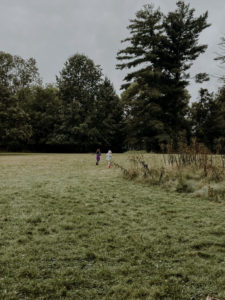
Outside of the forest classroom.
Since beginning my co-op position at the beginning of September, I have learned that exploration, curiosity, and play are key elements to learning. Children are brave and strong when you give them the space to be children, and at the Antioch School, the students have so many resources to use their imagination. I have co-opped in three different educational institutions. My first co-op was at Paraclete, an after-school program in South Boston. I then co-oped at Buen Día Family School, a bilingual arts-based school in San Francisco. My most recent co-op was at the Yellow Springs High School here in the village during the pandemic. However, I have never worked at a place like the Antioch School. Whenever I talk to parents when they pick up their children at the end of the day, I always hear the same things, “I wish I could have gone here as a kid,” or “Man, if only every kid could go to a school like this,” and I share theses exact same sentiments. It is imperative that we let children be children. It is important that we let our children explore and create without fear of messing up. Through play and curiosity, the children at the Antioch School learn important things such as the value of choice and consequences. The children here at the Antioch School are supplied with the resources to collaborate with other students, work together to problem-solve, and explore the natural world. Being at the Antioch School, I have seen what a healthy trusting educational experience can look like. Through self-discovery and looking at the whole child rather than just an academic side of a student, the children at the Antioch School spend every day loving their school and their community, something a lot of us weren’t lucky enough to experience as a child. The amount of agency the students have at the Antioch School is truly freeing in a way that I didn’t know education could be and the daily activities I have been doing with the students like hunting for fairies, making potions, or even just playing Capture the Flag have been healing. The students and teachers at the Antioch School are teaching me to slow down and to see the fairy ponds; to see the wonder, magic, and beauty of each day.
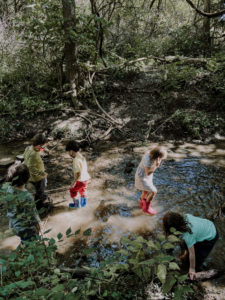
Wading in the Jacoby creek.
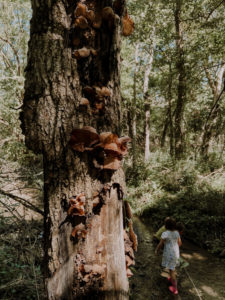
Magical mushrooms found on a tree by Jacoby creek

A tree found on our Glen hike.
“As important to the children as the development of academic skills is their emotional, social, and physical growth. Children are encouraged to realize their capabilities in the whole spectrum of living. Love, respect, encouragement, letting the children be– these are the most important parts of the curriculum. The children learn self-discipline, they learn to use self-initiative, they learn to make choices. They learn to help others. They learn to try, not to be afraid to do. And mostly, they experience the joy of being children.” Antioch School Parent-Teacher Curriculum Committee, 1979
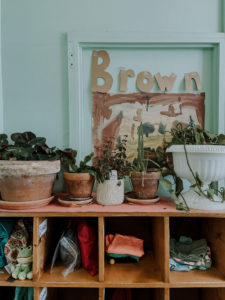
Inside of the school details.
Quotes are taken from Wallis, Don. Children of a Child-Centered School. OYO Press, 2005.
A day in the life at the Antioch School:
10:00 am – Arrival. I start my day off with the Older Group. Usually, when I arrive at 10:00, students are scattered throughout the playground. Some students ride tricycles and unicycles around the playground while others swing on the swings, play on the monkey bars and merry-go-round, and some students play group games like Capture the Flag or Circle Freeze Tag.
11:00 am – Time for “Independent Work.” I help students with their independent work packets. I help OG students review their spelling words for their spelling tests. I also help them with long division and multiplication, even though I had to get a refresher on this lesson as well!
11:30 am – Lunchtime. I sit with OG students outside while we stay six feet apart. We all eat our lunches together and play a riveting guessing game to figure out what everyone has for lunch. I have something that is red, it’s a fruit, and it’s not an apple. Can you guess what it is?
12:00 pm – Free time. The students are given time to explore and rest. I wander around the school attending to the different groups of children. I make sure everyone is accounted for and safe. This time I also use to water plants around the building sometimes.
12:30 pm – Read Aloud Time. This is my favorite part of my day. Sally (the OG teacher) and I corral all the students to the back of the school. This is where we have read-aloud time where Sally reads from a book and the students listen, draw, and sit quietly while she reads. We have been reading Wonder by R.J. Palacio which is an incredibly engaging book, especially the way that Sally reads it.
1:00 pm – History Lesson or Group Game. This time of the day students are given a history lesson or time to play a group game together. Some group games we came up with for this year are: Color Freeze Tag, Capture the Flag, Charades, Twenty Questions, Pictionary, and Hangman.
1:45 pm – Forest Kindergarten Classroom. At this time I walk to the Kindergarten forest classroom. I find the Kindergarteners usually playing in the leaves and chasing chipmunks or fairies around. At this time, I help the Kindergarten teacher Linde with corraling the Kindergarteners to pack their stuff up and do their end of the day jobs. I usually help the students pick up sand toys and at the very end of our day, I help the Kindergarteners pack their backpacks up with their creations from the day along with their lunch pails, fun treasures (sticks, yarn, rocks, acorns), and jackets.
3:00 pm – Going back home. At around 3:15 or 3:30 every day, I leave the Antioch School and prepare for the next day of adventure.
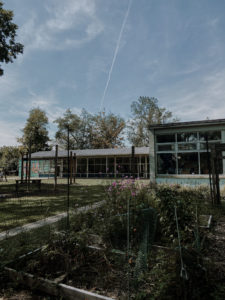
The outside of the school from the garden area.

Garden find.

The garden.
The Pandemic as a Teachers Assistant: Lexi Payton ’22 at Yellow Springs High School in Yellow Springs, Ohio
Mar 22, 2021“Absurd times call for absurd amounts of love.” – Brad Montague
Last week I received my first dose of the COVID-19 vaccine because I am working for the Yellow Springs High School on my winter co-op. All my life I have had an irrational fear of needles, but for this vaccine, in particular, I toughened it out. Maybe it was the fact that I had to go into the school alone to get my shot so I had already built up a sense of independence. Or maybe it was spending three months in Boston by myself in a previous co-op. Or maybe it was just the fact that the COVID-19 virus has killed over 500,000 people in the United States alone (this new number just being surpassed a week after my 21st birthday). But no matter what it was, I really felt brave, and ultimately I felt really grateful at this moment.
I stood in line in a school filled with teachers guiding people from one hallway into another, leading to a room filled with people standing in different lines. The lady standing in front of the doorway directed me to the third line, “Ma’am, yes, ma’am, I am going to need you to go to line three, yes that line over there. Yes behind the man in the blue shirt.”
Teachers really are superheroes, and after seeing what teachers have been doing for their students during this pandemic, there truly is no denying that.
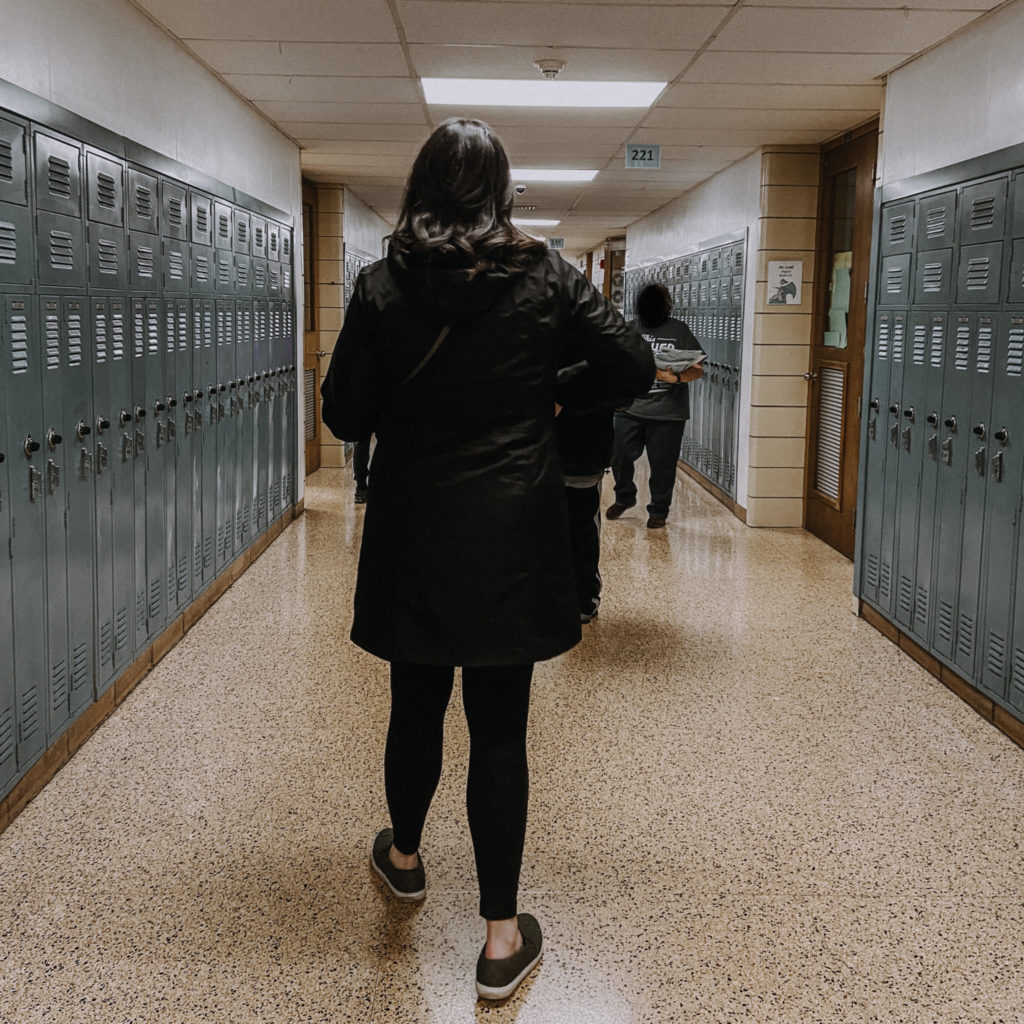
Thinking back to the first time I heard of the virus was when I was on my previous co-op in San Francisco, California. It was warm there and I had so much fun exploring such a beautifully artistic and historically-rich place. I ate so much good food with my boyfriend and every single day was an adventure. The teachers there radiated joy and love. Before my trip to San Francisco, I traveled to Boston where I met so many amazing people and friends. I explored a brand new city all by myself. Boston was a gorgeous place where I also ate a lot of great food and had a lot of fun. The teachers in Boston taught me that kindness and empathy are essential as an educator. The more that I reflect on the previous twelve months and my time as a student at Antioch, I know exactly why I wasn’t afraid to get the vaccine. I started my co-op at the Yellow Springs High School in January of 2021 and when I walked into the high school, I couldn’t even shake the principal’s hand. During the pandemic, our habits, routines, and lifestyles have drastically changed. It is ultimately a privilege to be able to say that I am tired of COVID-19 and that I am blessed I get to see another day, but I can’t help but admit that I miss life before when things felt natural, fun, and overall more connected. More precisely, I miss hugs and being able to see people’s smiles.
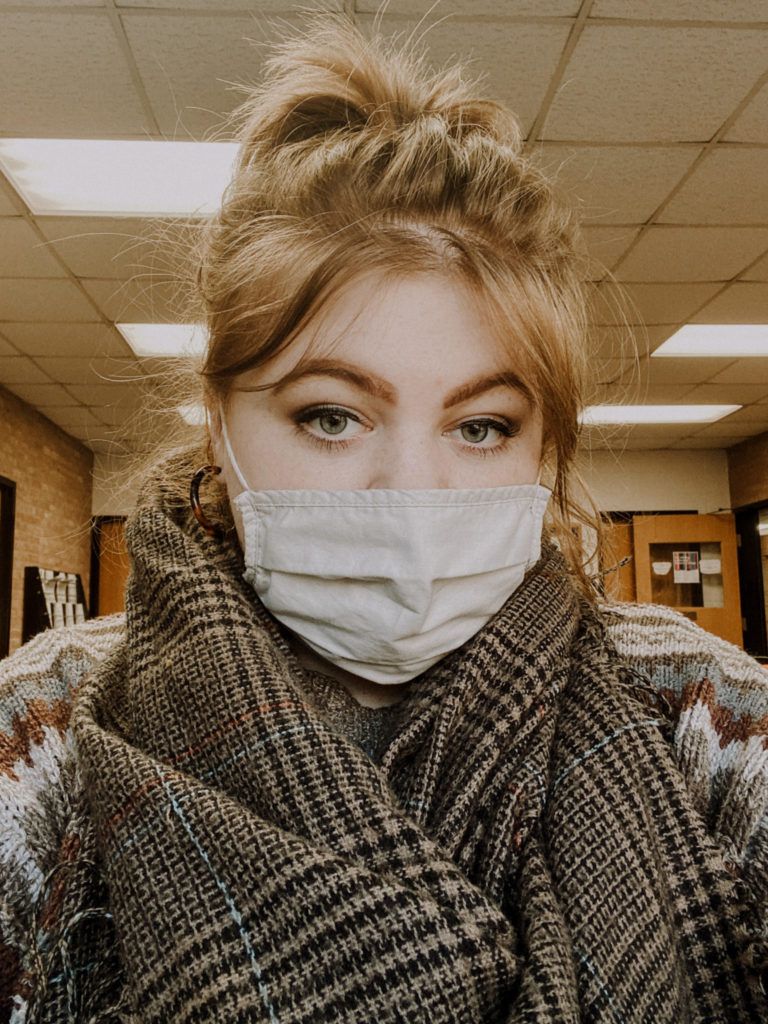
In 2020, I walked into the school building with all of the windows surrounding me and I was ecstatic to be working at a new school, although I have to admit, I was a little nervous to be working with the older students. In the fall of 2020, I met with someone from the high school outside of the school on a picnic bench. It was a windy day, and she and I talked about the many possibilities I had of starting at the high school as the leaves in the big oak tree above our heads swayed. During this entire conversation, my hair (that is growing out from a shaved head) was blowing all over my face. I was laughing the entire interview and I drove home that day smiling from ear to ear. I had so many possibilities if everything went right. I could work with a Spanish-speaking student and help them with English while they help me with Spanish! Or I could read to younger children, or even help students with cognitive disabilities organize their classes. I was nervous but also thrilled at the prospect of working with older students and hopefully becoming a big-sister type mentor. This was a conversation that took place when we were all hoping that COVID would somehow not enter into 2021. I really held onto that hope for a long time. I have been wearing my mask. I have been staying home and social distancing. I have been doing everything as I am supposed to.
Over this past co-op, I have been working remotely on campus for the Yellow Springs High School. Specifically, I am emailing parents and students about the reading program Lexia. I mostly make calls and email parents most days telling parents that this program is designed to help struggling and nearly-proficient readers in grades 6–12 become proficient readers and confident learners. I work with students and parents alike to answer questions on Lexia Powerup so that students can access the site. But to be completely truthful, I am still learning how to process not being able to see students in-person, and I keep thinking about what my co-op would have been like if COVID-19 didn’t exist. Like teachers all across America, I feel as if I am mourning. I am mourning the experiences I wish I could be having and I am mourning as I see other people my age go out and party. However, although I am disappointed and sad, I am also trying my best to remain positive and stay grateful. I am disappointed I am working remotely and I am sad that I cannot form relationships with students in the way that I want to. However, it is a brand new year in 2021, and there is still so much left to do and see. I have been trying to find joy in the little things: footprints in a fresh coat of snow, the anticipation of sledding down a big hill, a trip to the campus library, watching a pet snail, or a rainbow forming in your room over your trash can and laundry hamper. I am learning to find joy in the little things, the things that are right here. I am learning how to be grateful for what is here and given while also trying to remain hopeful. Spring is almost here.
“I am learning to find joy right here in the mess of things.” – Morgan Harper Nichols
-
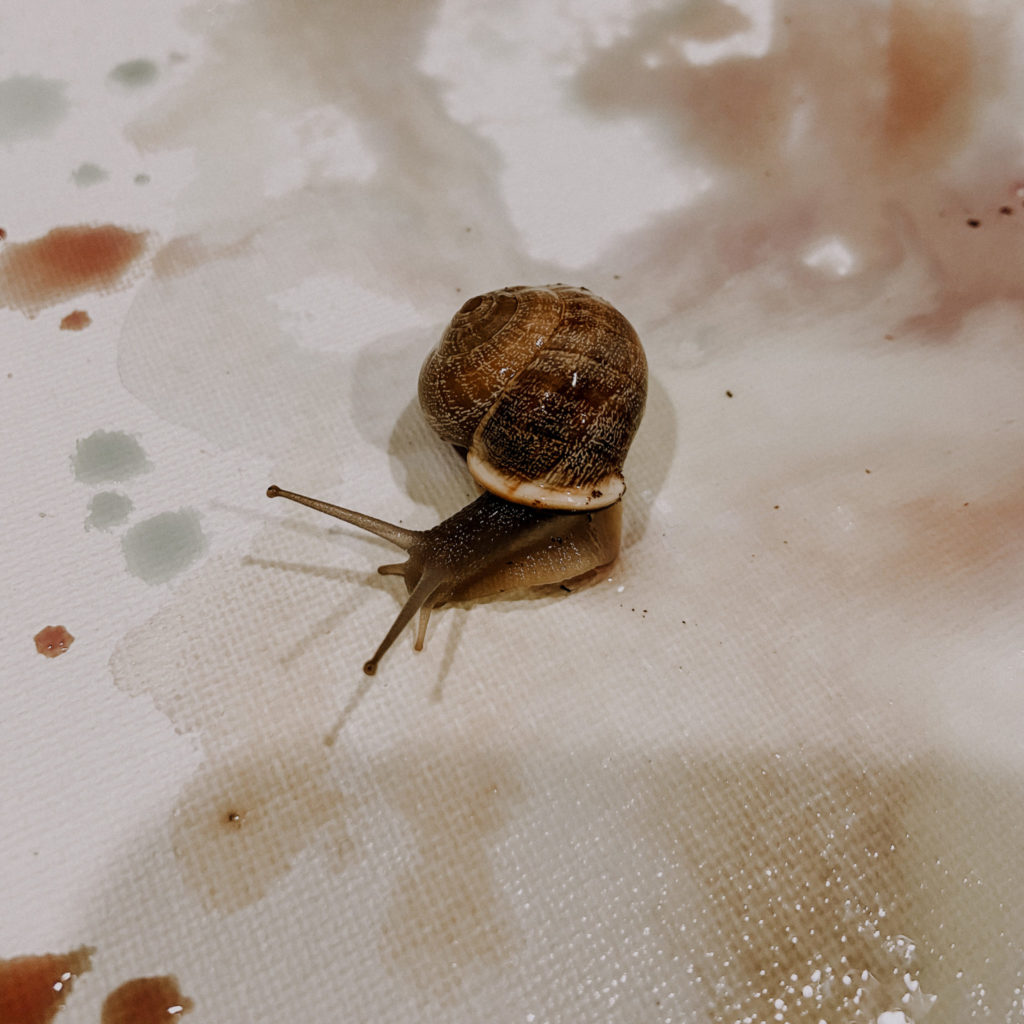
Misty the snail -

Rainbow = Joy -

The OKL -
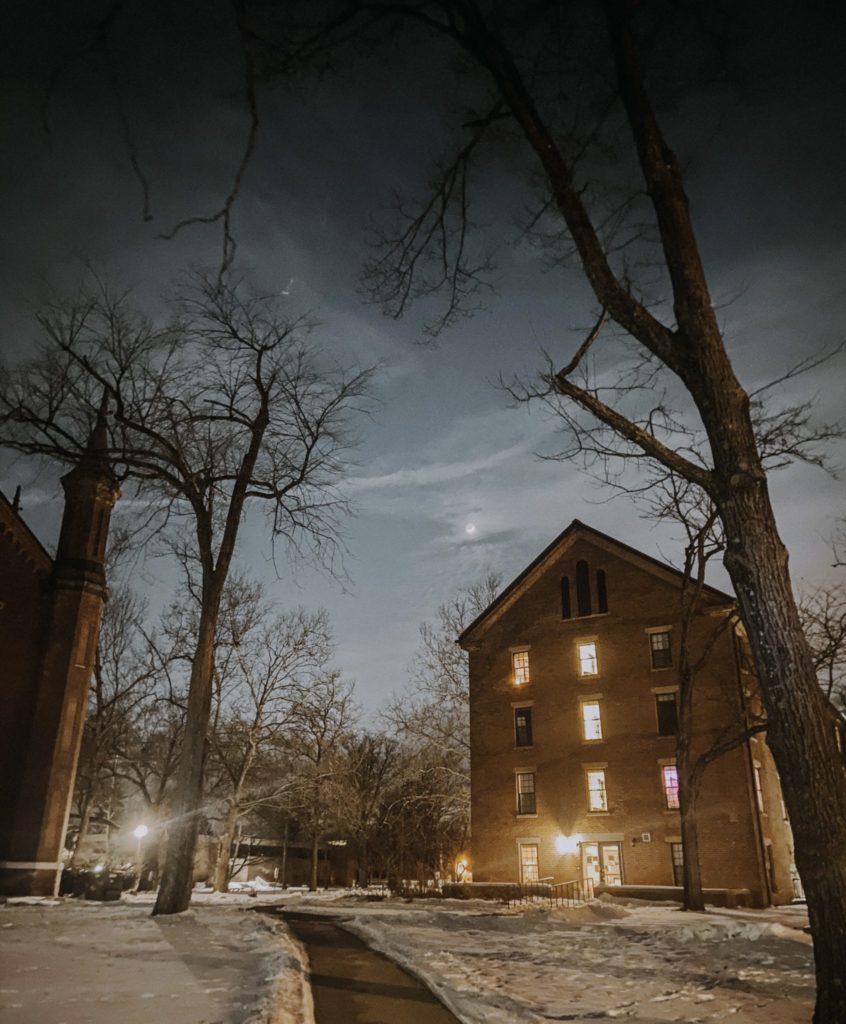
Antioch on a walk at night -
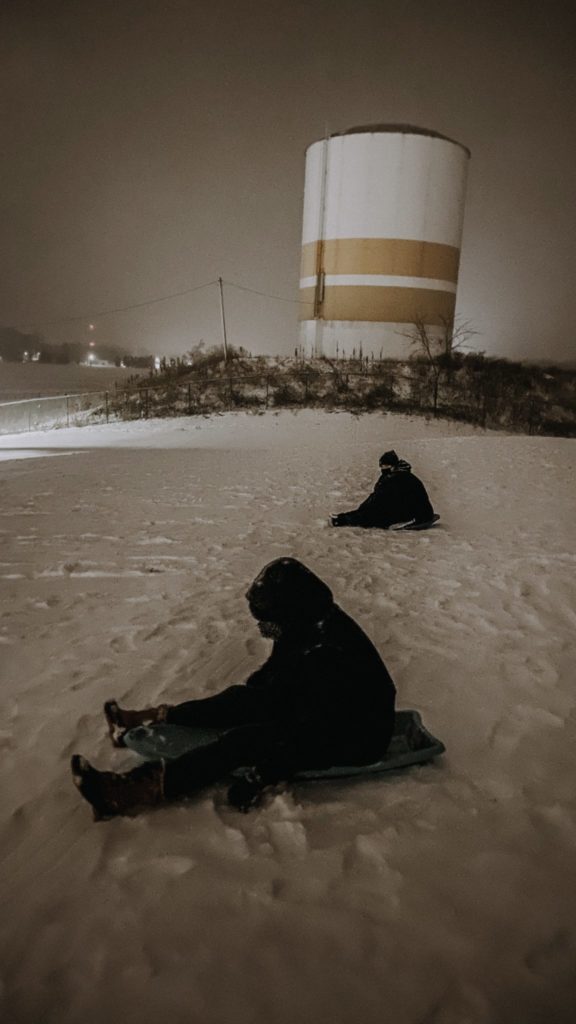
Sledding with Maya, Austin, and Noah -
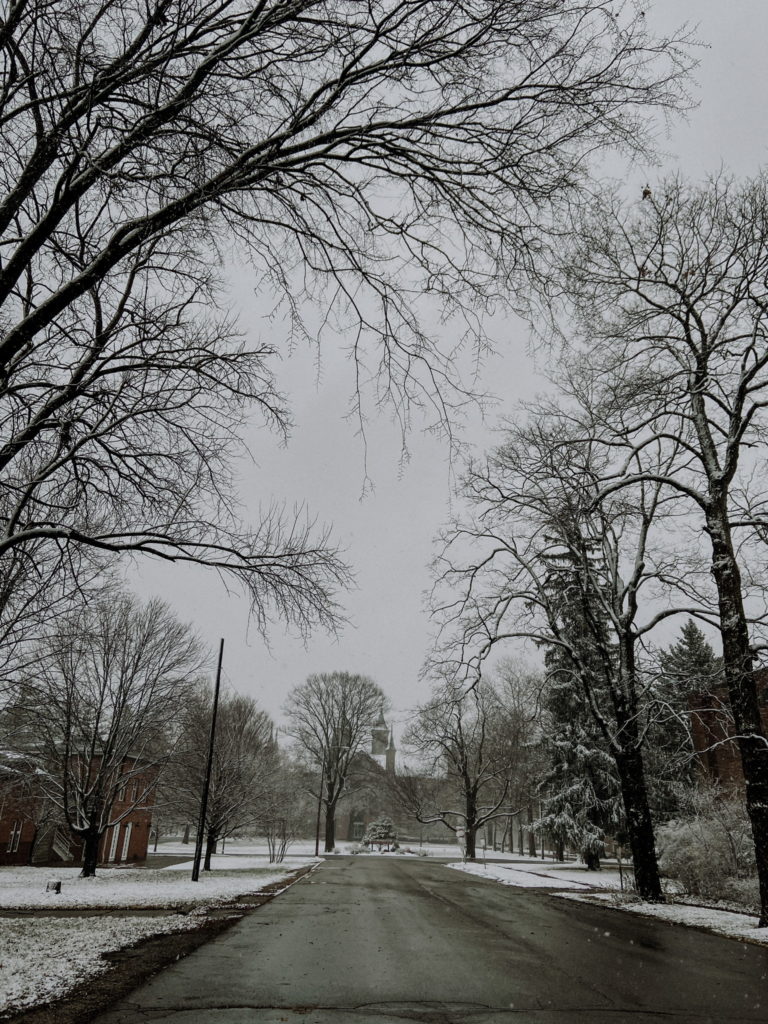
It is snowing in Yellow Springs ! -
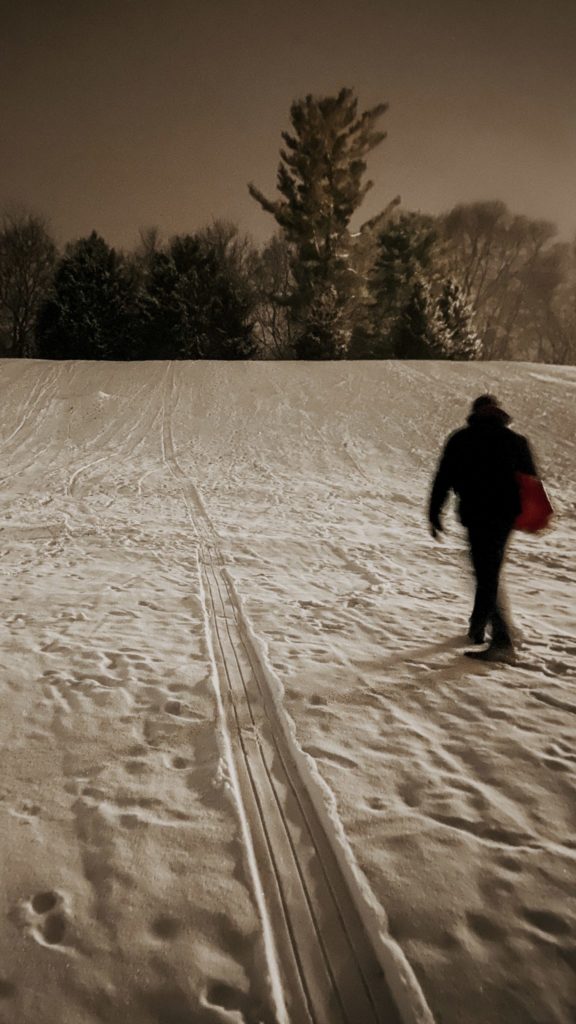
Sledding at Gaunt Park -
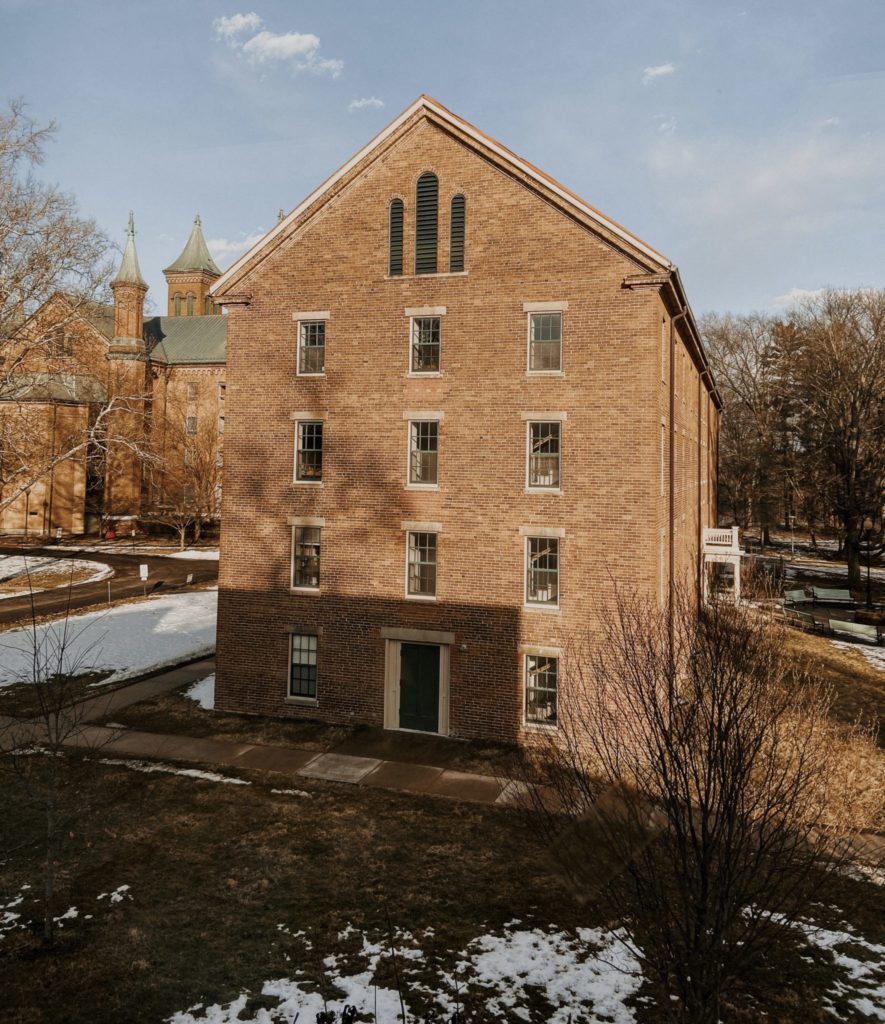
Antioch from the Writing Institute -

Antioch on a walk at night
Unapologetic: Payton ’22 at Buen Dia Family School in San Francisco, California
Mar 17, 2020Scratches and scribbles on purple paper, rocks and beads, “we found these for you teacher Lexi”.

Unapologetic
For years now, I have been indefinitely concerned with the idea of perfection. This lingering, strangling feeling of it doesn’t matter what I create, it will never be perfect, and it will never be how I want it to be.
Even as a kid I was plagued with this idea. When playing, I would pick the car that was unscratched. My lego houses would be made with one solid color or not at all. My journals would disappear from the ripped pages I tossed into the trash after spending hours writing.
At Buen Dia, the first rule I learned was to never draw for a child. The children would look at your drawing, and see that it is unflawed. They would see all the colors are in the lines, and that the shapes are perfectly drawn, therefore, the children wouldn’t want to try to draw, but instead they would ask you to draw for them. The children would compare their drawings to yours and insecurity would flood their tiny minds. The insecurities would take over and they would think that their drawings would never be as good as yours.
The kids at Buen Dia are taught that nothing in this world is perfect, so to strive for perfection is frivolous. Rather than striving for perfection, they strive for purpose, and for creation. They are taught that the act of creating something is always more important than the result.
The kids walk around the school with their hair half down and half in a tight pony or braid, the leftover remaining touch from their parents love in the morning. Their pants are ripped and their shirts are stained, and of course, they always have a little bit of dirt in their shoes. But in their tiny heads, there are big, ginormous, brilliant ideas flourishing. Buen Dia is a place where curiosity and wonder take precedence over anything else (except for safety of course!).
While here in San Francisco, the Buen Dia Family School has inspired me to exist without trying to please everyone, and thus I shaved my head. Just kidding, but no, I really did shave my head though.
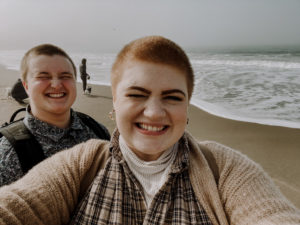
Me and Austin at Baker Beach
The kids at Buen Dia inspired me to exist unapologetically. Watching them fall down after climbing the monkey bars, and hit the ground hard, only to soon get back up, and try again taught me that searching for perfection leaves me empty. I am no longer searching for perfection. Now, I am searching for curiosity, wonder, and creation.
The Buen Dia Family School
The Buen Dia Family School is a preschool in the Mission District of San Francisco. Buen Dia focuses on art and has a bilingual Spanish component. Some students speak both English and Spanish, and some just speak one or the other. Family at Buen Dia is important. It is a requirement for guardians to input work at Buen Dia to help make the school function well. Some parents prefer to do office work while others go on field trips with the students. The Buen Dia mission is to empower children to meet their potential, encourage individual expression, and enhance self confidence.
Buen Dia is a small building located on the corner of 18th and Guerrero Street. I walk up the steps to the front door and enter in the building code. Here, I am always greeted with tiny hugs and smiles.
I start my day off at Buen Dia working in the upstairs office. I spend the first hour of my day drinking coffee from my travel mug and organizing files. I also input data into the computer, help with auction work, and my personal favorite- shred a lot of paper (who would have thought shredding paper would be so fun).
At the end of my office shift, I take a small ten minute break, then head downstairs where I assist the teachers. From here, we lead sixteen tiny humans to the lower level of the building where they lay down on mats with their stuffies in hand.
In Cave (what we call the older kids’ nap time), we relax our bodies and minds by practicing mindfulness. We only use our whisper voices, we raise our hands, and we stay on our own mats. The teacher reads a few stories, and then the kids lay down for fifteen minutes. The lay down is accompanied by a soft peaceful music, or a white noise.
At 2:00 p.m, Cave’s ending approaches and the kids scramble upstairs to play.
At one table there is always arts and crafts where the teacher leads an activity like making paper birds or collaging, but rules are never enforced here. At the arts and crafts table creativity is encouraged.
The kids are also invited to play outside on the play structure, the monkey bars, the slide, or even just in the sand! There are always activities placed outside on the tables too! Tiny dinosaurs and legos are the favorites that I have noticed.
The kids also have the option to help with afternoon snack. Today for snack we had bread with almond butter, oranges, and rainbow carrots! The kids assisted me and cut the carrots into bite-size sticks.
I take a thirty minute lunch break at 3:30. The next few hours I spend with the teachers and staff at Buen Dia playing with the kids.
We play everything from dress-up, to kitchen, to… THE TICKLE MONSTER IS COMING EVERYONE HIDE.
At Buen Dia, there are many options for the children’s play, after all, that is how children learn. I end my day with tiny hugs and smiles and “goodbye teacher Lexi, I see you tomorrow”.
Thank you Buen Dia.
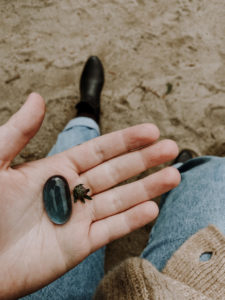
“I found these for you teacher Lexi”
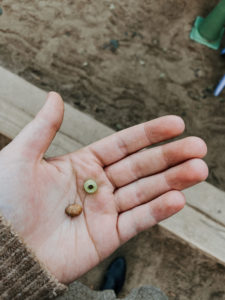
Part 2: “I found these for you teacher Lexi”
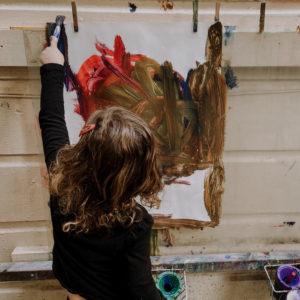
The Truth About Teaching: Payton ’22 at Paraclete Academy in Boston, Massachusetts
May 30, 2019I have always described myself as a living paradox. I like my room to be clean, very clean. In fact, I start everyday by making my bed, and I vacuum my floor before the night ends. However, I am an absurdly messy eater. I eat with my hands, I never use napkins, and I usually end up with food on my forehead.
I am insecure and aloof in one moment, and then narcissistic the next. I enjoy solitude, but I’m afraid of being alone.
I have never been a fan of chaos, but my passion in life is teaching kids.
The Truth About Teaching
The students cobbled together, sprinting into the building, screaming and fighting with each other.
We were in for a treat: the day after spring-break treat. A treat that would lead to our ultimate demise.
I thought to myself, why did break have to end? The sleeping in until noon and then taking the T to downtown to explore and read in Boston Common. Maybe stop for a coffee but definitely stop for lunch and then get back to Paraclete to FaceTime my friends back home, and write in my journal. This had been my previous week, a week of break, a week of sweet freedom, a week without screaming kids.
Is this how the rest of my life is going to be like? Am I going to be waiting for Fridays, for weekends, for breaks?
As the night went on I made slime with a student Raiandy, a short and spunky fourth grader who laughs at absolutely everything. He made a plan to create a stress ball with his newly acquired slime and a rubber glove.
I began to embrace the chaos that was around me, and I could feel myself find joy in tiny things.
“Sounds like a plan, Stan,” I said to him.

Stan the man
”My name isn’t Stan,” he giggled.
“Oh yeah… That’s right. Your name is Raiandy, right? Not Stan.”
“DUH. But what if my name was Stan? Oh my god, I should name my little guy Stan. Stan the man!”
And so it was, his rubber glove son was born and his name was Stan the man. Sadly, Stan the man’s life was short lived. Another kid who squeezed him too tight popped the rubber glove. Raiandy rushed to me.
“Lexi!! Help!! Stan the man is in trouble! He needs surgery!!” Raiandy bellowed.
We spent the rest of the afternoon doing surgery, transferring Stan’s blood into another “body”. A different type of blood transfusion I suppose. Raiandy and I are breaking surgical history with our method.
“What would I have done without you here? What if you hadn’t have came to Paraclete and you stayed in Ohio?” Raiandy asked, his big brown eyes peering behind his over-sized glasses.
“Stan the man, would be no more, Raiandy.”
“Exactly! It’s a good thing you are here.”
I was no longer reminiscing, I was living.
Although silly, this is an example as to why every day matters as a teacher. My goal within this life is to cultivate a career where I am not wishing away every day of the week. This job is difficult, no doubt. It often times leaves you feeling exhausted and sometimes even defeated at the end of the day. But each day is a day that could change a student’s life, or maybe save a student’s rubber-glove-man’s life.
I can’t wait for Fridays, for weekends, for breaks. Every day is a day I need to be here, and be present, and indulge in the chaos. Each day matters.
Paraclete (The Academy, After School Program, Center)
This must be it, I insisted as I pulled up to Paraclete on April 6, 2019. The building itself (a massive brick cube with a thousand windows) was incredibly distinguishable from the rest of the street. Here, buildings that all look the same sit on top of each other. But Paraclete was its own building and it declared its own space. The building screams it’s character. It’s quirky and old, but it has a beautiful story to tell.

This repurposed convent is surrounded by a black gate that’s wrapped in ivy. On the left, there is a large patch of grass and a blooming magnolia tree. On the right, there is a smaller patch of grass and the driveway, leading to the back of the building where kids play basketball, hopscotch, four-square, football, and endless creative variations of these activities.
Monday through Friday each week, around thirty students (ranging from fourth grade to eighth) from local South Boston schools come to Paraclete for homework help and enrichment classes such as cooking and creative arts.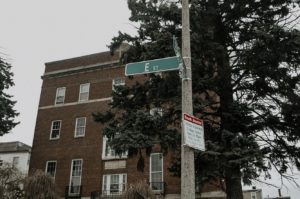
Although, the building is alluring, the building itself is not what gives Paraclete its character. The people inside Paraclete are what makes Paraclete the gleamingly stunning establishment it is. The teachers and staff here at Paraclete are inherently caring individuals, always positive and always looking to help. The students here at Paraclete are loud and chaotic, but they are good, smart, and kind.
Paraclete holds a space for these students of South Boston to flourish and learn. But it is not only an encouraging space for educational growth, but personal growth as well. I have seen individual growth from almost all of the students here, whether it be a shift in language and tone or a change of energy, from negative to positive, the kids here are learning to be better people everyday.
In the short amount of time I have been here, I can also report that Paraclete has inspired growth within my own personal life. I have not only learned from the teachers here, but the students as well, who teach me that every single day is important.
I think I love the contradiction. I think I love the paradoxical life.
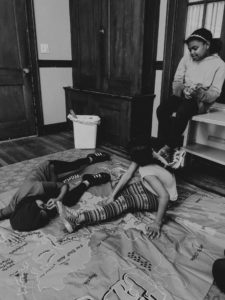
Sumio, Nona, and Kim playing Map Twister
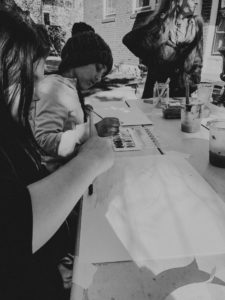
Olivia and Kim painting with watercolors
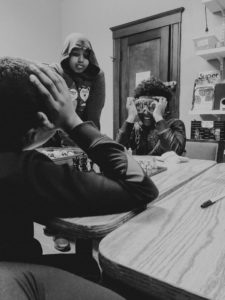
Raiandy, Saladin, and Khalid “teaching” me how to play chess






